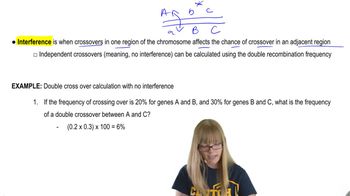Table of contents
- 1. Introduction to Genetics51m
- 2. Mendel's Laws of Inheritance3h 37m
- 3. Extensions to Mendelian Inheritance2h 41m
- 4. Genetic Mapping and Linkage2h 28m
- 5. Genetics of Bacteria and Viruses1h 21m
- 6. Chromosomal Variation1h 48m
- 7. DNA and Chromosome Structure56m
- 8. DNA Replication1h 10m
- 9. Mitosis and Meiosis1h 34m
- 10. Transcription1h 0m
- 11. Translation58m
- 12. Gene Regulation in Prokaryotes1h 19m
- 13. Gene Regulation in Eukaryotes44m
- 14. Genetic Control of Development44m
- 15. Genomes and Genomics1h 50m
- 16. Transposable Elements47m
- 17. Mutation, Repair, and Recombination1h 6m
- 18. Molecular Genetic Tools19m
- 19. Cancer Genetics29m
- 20. Quantitative Genetics1h 26m
- 21. Population Genetics50m
- 22. Evolutionary Genetics29m
4. Genetic Mapping and Linkage
Multiple Cross Overs and Interference
Problem 34
Textbook Question
Because of the relatively high frequency of meiotic errors that lead to developmental abnormalities in humans, many research efforts have focused on identifying correlations between error frequency and chromosome morphology and behavior. Tease et al. (2002) studied human fetal oocytes of chromosomes 21, 18, and 13 using an immunocytological approach that allowed a direct estimate of the frequency and position of meiotic recombination. Below is a summary of information [modified from Tease et al. (2002)] that compares recombination frequency with the frequency of trisomy for chromosomes 21, 18, and 13. (Note: You may want to read appropriate portions of Chapter 8 for descriptions of these trisomic conditions.) Trisomic Mean Recombination Live-born Frequency Frequency Chromosome 21 1.23 1/700 Chromosome 18 2.36 1/3000–1/8000 Chromosome 13 2.50 1/5000–1/19,000 Other studies indicate that the number of crossovers per oocyte is somewhat constant, and it has been suggested that positive chromosomal interference acts to spread out a limited number of crossovers among as many chromosomes as possible. Considering information in part (a), speculate on the selective advantage positive chromosomal interference might confer.
 Verified step by step guidance
Verified step by step guidance1
Understand the concept of chromosomal interference: Chromosomal interference refers to the phenomenon where the occurrence of a crossover in one region of a chromosome reduces the probability of another crossover occurring nearby.
Review the data provided: Note the recombination frequencies and the live-born trisomy frequencies for chromosomes 21, 18, and 13.
Consider the role of recombination: Recombination during meiosis is crucial for genetic diversity and proper segregation of chromosomes. A higher recombination frequency can lead to more genetic variation.
Analyze the relationship between recombination frequency and trisomy: Observe that chromosomes with lower recombination frequencies (like chromosome 21) have higher incidences of trisomy, suggesting that recombination may help prevent nondisjunction.
Speculate on the selective advantage: Positive chromosomal interference might ensure that crossovers are distributed across different chromosomes, reducing the likelihood of nondisjunction and thus decreasing the risk of developmental abnormalities like trisomy.
Recommended similar problem, with video answer:
 Verified Solution
Verified SolutionThis video solution was recommended by our tutors as helpful for the problem above
Video duration:
1mPlay a video:
Was this helpful?
Key Concepts
Here are the essential concepts you must grasp in order to answer the question correctly.
Meiotic Errors
Meiotic errors occur during the process of meiosis, where chromosomes are segregated into gametes. These errors can lead to aneuploidy, such as trisomy, where an individual has an extra chromosome. Understanding the frequency and types of meiotic errors is crucial for analyzing their impact on human development and the correlation with conditions like Down syndrome (trisomy 21).
Recommended video:
Guided course

Proofreading
Recombination Frequency
Recombination frequency refers to the rate at which genetic recombination occurs during meiosis, leading to genetic diversity in gametes. It is influenced by factors such as chromosome morphology and the number of crossovers. Higher recombination frequencies can be associated with increased genetic variation, but may also correlate with higher rates of chromosomal abnormalities, as seen in the study of chromosomes 21, 18, and 13.
Recommended video:
Guided course

Recombination after Single Strand Breaks
Positive Chromosomal Interference
Positive chromosomal interference is a phenomenon where the occurrence of a crossover in one region of a chromosome reduces the likelihood of another crossover occurring nearby. This mechanism helps to distribute crossovers more evenly across chromosomes, potentially minimizing the risk of meiotic errors. Understanding this concept is essential for speculating on its selective advantages, such as enhancing genetic diversity while reducing the likelihood of severe chromosomal abnormalities.
Recommended video:
Guided course

Positional Cloning

 6:14m
6:14mWatch next
Master Multiple Cross Overs and Interference with a bite sized video explanation from Kylia Goodner
Start learningRelated Videos
Related Practice


